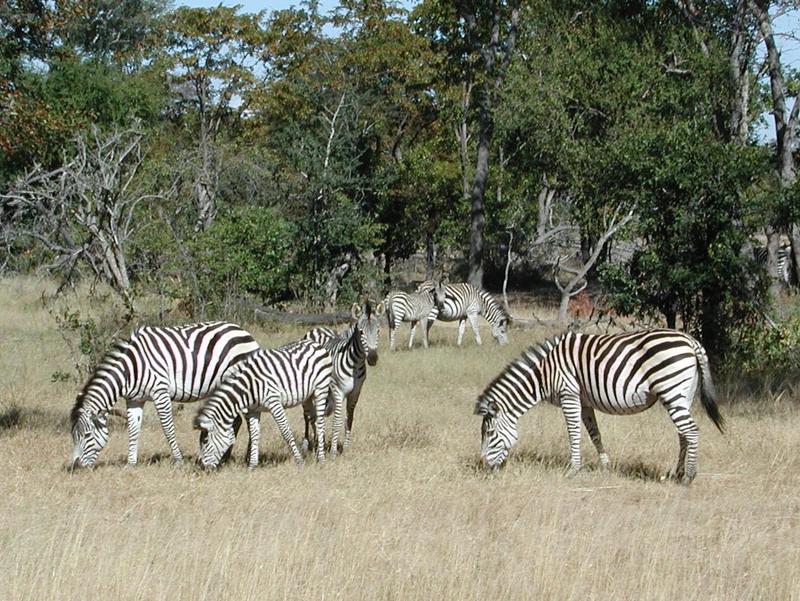|
| Query: Selous' zebra | Result: 6th of 6 | |
Plains Zebra (Equus quagga) - Wiki
| Subject: | Plains Zebra (Equus quagga) - Wiki
| |

| Resolution: 1296x974
File Size: 273717 Bytes
Upload Date: 2007:10:17 23:04:18
|
Plains Zebra
From Wikipedia, the free encyclopedia
[Photo] Plains Zebra (Equus quagga). Beschreibung: Grazing plains zebras (Mosi-oa-Tunya National Park). Subspecies: Equus quagga boehmi. Lives according to Groves & Bell (2004) "Zambia west of the Luangwa...". Peter Maas 09:38, 6 April 2006 (UTC). Source: http://www.fourmilab.ch/images/eclipse_2001/africaimages.html Photo by Peter Maas (http://commons.wikimedia.org/wiki/User:Pmaas). License: public domain
The Plains Zebra (Equus quagga, formerly Equus burchelli), also known as the Common Zebra or the Burchell's Zebra, is the most common and geographically widespread form of zebra, once being found from the south of Ethiopia right through east Africa as far south as Angola and eastern South Africa. The Plains Zebra is much less numerous than it once was, because of human activities such as hunting it for its meat and hide, as well as encroachment on much of its former habitat, but it remains common in game reserves.
Physical description
The Plains Zebra is mid-sized and thick bodied with relatively short legs. Adults of both sexes stand about 1.4 meters (4.6 ft) high at the shoulder, are approximately 2.3 meters (8 ft) long, and weigh about 290 kg (638 lbs). Like all zebras, it is boldly striped in black and white and no two individuals look exactly alike. All have vertical stripes on the forepart of the body, which tend towards the horizontal on the hindquarters. The northern species have narrower and more defined striping; southern populations have varied but lesser amounts of striping on the underparts, the legs and the hindquarters. The first subspecies to be described, the Quagga which is now extinct, had plain brown hindquarters. (Technically, because the Quagga was described first as E. quagga, the proper zoological name for the most common form of the Plains Zebra is E. quagga burchelli.)
Lifestyle and reproduction
The Plains Zebra is highly social and usually forms small family groups consisting of a single stallion, one, two, or several mares, and their recent offspring. Mares have a dominance hierarchy. The stallions first mates with the alpha zebra and then down. The oldest mare has the responsibility of leading the group when they move to different areas. Bachelor males either live alone or with groups of other bachelors until they are old enough to challenge a breeding stallion.
Plains zebra mating peaks in the rainy season. The newborns are able to stand, walk and suckle moments after they ae born. The foals are protected by the harem.
Plains zebra groups are permanent, and group size tends to vary with habitat: in poor country the groups are small. From time to time, Plains Zebra families group together into large herds, both with one another and with other grazing species, notably Blue Wildebeests.
Habitat and foraging
Unlike many of the large ungulates of Africa, the Plains Zebra prefers but does not require short grass to graze on. In consequence, it ranges more widely than many other species, even into woodland, and it is often the first grazing species to appear in a well-vegetated area. Only after zebras have cropped and trampled the long grasses do wildebeests and gazelles move in. For protection from predators like lions and spotted hyenas, the Plains Zebra retreats into open areas with good visibility at night time, and takes it in turns standing watch. It eats a wide range of different grasses, preferring young, fresh growth where available, and also browses on leaves and shoots from time to time.
Subspecies
In 2004, C.P. Groves and C.H. Bell did investigations on the taxonomy of the zebra's genus Equus, subgenus Hippotigris. They published their research in Mammalian Biology. They revised the subspecies of the Plains Zebra Equus quagga. Six subspecies are recognizable. The completely maneless Somali population may represent a seventh subspecies: Equus quagga isabella (Ziccardi, 1958). This subspecies may be valid, but at present there is no evidence that it is.
* Quagga, Equus quagga quagga Boddaert, 1785 †
* Burchell's Zebra, Equus quagga burchellii Gray, 1824
* Grant's Zebra, Equus quagga boehmi Matschie, 1892
* Selous' zebra, Equus quagga borensis L??nnberg, 1921
* Chapman's Zebra, Equus quagga chapmani Layard, 1865
* Crawshay's Zebra, Equus quagga crawshayi De Winton, 1896.
http://en.wikipedia.org/wiki/Plains_Zebra
| The text in this page is based on the copyrighted Wikipedia article shown in above URL. It is used under the GNU Free Documentation License. You may redistribute it, verbatim or modified, providing that you comply with the terms of the GFDL. |
|
Comments |
|---|
| | Guest |
|
Scientific Name: Equus quagga Boddaert, 1785
Common Names: Plains Zebra, Burchell's Zebra, Common Zebra, Painted Zebra
Synonyms:
Equus burchelli (Gray, 1824) [orth. error]
Equus burchellii Schinz, 1845 |
^o^
Animal Pictures Archive for smart phones
^o^
|
|
|